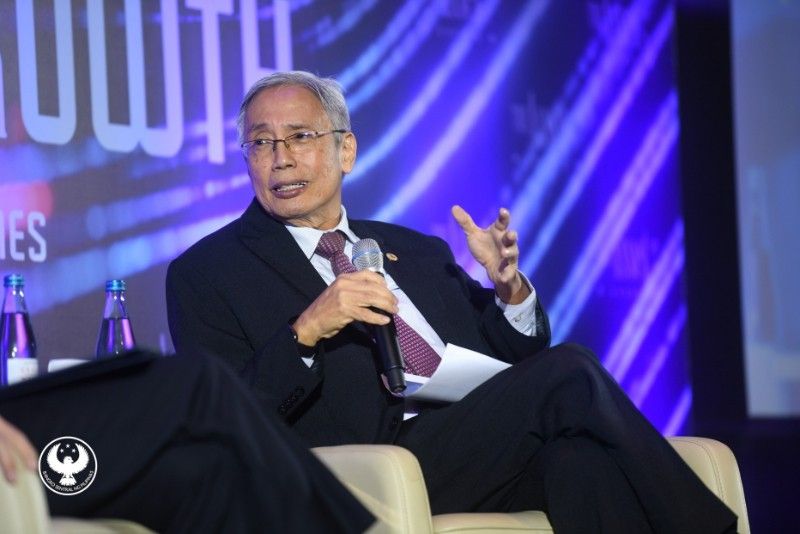BSP continues inflation fight but goes easy with rate hikes

MANILA, Philippines (Updated 4:36 p.m.) — The Bangko Sentral ng Pilipinas fell lockstep with the US Federal Reserve’s rate action on Thursday as it continued to hike interest rates to combat inflation within the domestic economy.
Following its rate-setting meeting on Thursday, the Monetary Board raised interest rates by 50 basis points. Banks and financial institutions use this benchmark rate for setting interest rates on loans.
This brought the benchmark rate to 5.5%. The last time interest rates were at this point was back in December 2008, at the thick of the Global Financial Crisis.
The latest adjustment, however, was softer than the previous round of hikes that saw rates jump by 75 basis points in one meeting.
Today’s announcement was no surprise as BSP Governor Felipe Medalla disclosed the decision weeks ago as inflation has yet to show signs of easing. The prices of consumer goods and services accelerated to 8% year-on-year in the previous month, the highest print since November 2008, when the Global Financial Crisis affected inflation.
At the same time, the series of outsized rate hikes in the US is sinking the Philippine peso to record-lows after record-lows, forcing the BSP to become one of the most hawkish central banks in the region. It was only in recent weeks that the peso was able to hold its ground, after the central bank vowed to defend the local unit against speculation.
Central banks, like the BSP, inject rate hikes to temper inflation within an economy. Ideally, rate hikes effectively control consumption, since higher interest rates would force consumers and businesses to think twice about borrowing money.
Inflation forecast
The BSP tweaked its inflation forecast for 2024, now at a lower 2.8% from the previous 3.1%. The revised outlook for that year accounted for declining oil prices, the peso’s appreciation and slower economic growth due to interest rate adjustments.
The BSP said that the impact of rate hikes on economic growth, particularly by 2024, would only amount to 19 basis points or 0.19%.
The central bank said it expects inflation to slow down in 2023, with inflation peaking this December. The prices of consumer goods and services would hit their highest point this month since BSP Governor Felipe Medalla said they were surprised with the inflation outturn in November.
Inflation would revert back to the BSP’s target of 2-4% by the third quarter. By the last quarter of 2023 and the first quarter of 2024, the central bank expects inflation to hit the target’s low range due to base effects.
For Jun Neri, lead economist for Bank of the Philippine Islands, the central bank’s actions were more than warranted.
“BSP needed to hike more aggressively to keep inflationary expectations well anchored as both core and headline inflation remain well above the policy rate,” he said in a Viber message.
Neri reckoned that the aggressive monetary policy stance was justified since inflation in the Philippines, suffering from supply constraints, moved faster than its regional peers.
Nicholas Antonio Mapa, senior economist at ING Bank in Manila, explained the difference between an aggressive rate hike and a sheepish stance.
“A more aggressive rate hike at this juncture, with peso no longer under intense depreciation pressure and import trends showing the ill effect of aggressive tightening can be considered as overkill,” he said in a Viber message.
Despite this, Medalla said “there’s a good chance” that the 50 bps hike would be the central bank’s most aggressive action in months to come, but did not rule out the possibility of larger increases owing to developments.
Rate hikes seep into the domestic economy six months or so after the central bank sets it, as was the case when credit growth broke an eight-month losing streak in August 2021.
“Meanwhile, offloading a 25 bps rate hike at this juncture would whittle down the differential and leave the currency susceptible to renewed speculative attacks,” Mapa added.
RELATED STORY: ‘BSP has $30 billion more to defend peso’
Domini Velasquez, chief economist at China Banking Corp., said he expects the BSP’s rate hikes to continue in 2023 since core inflation is still rising and will possibly peak in the first quarter.
“This means that aside from the December hike, the BSP will continue its monetary tightening cycle until early next year,” she said in a Viber.
Velasquez forecast that the terminal rate for the BSP is 6%, with inflation set to average 4.6% next year.
- Latest
- Trending





























